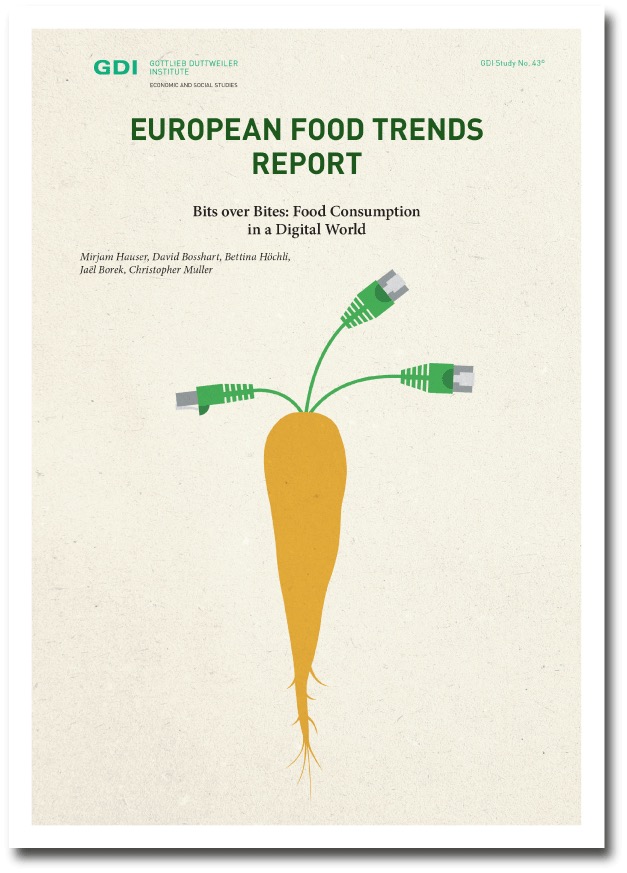European Food Trends Report 2015 (EN)
Bits over Bites: Food Consumption in a Digital World
Authors: Mirjam Hauser, David Bosshart, Bettina Höchli, Jaël Borek, Christopher Muller
GDI Study No. 43
Languages: German, English
2015
European Food Trends Report 2015
Bits over Bites: Food Consumption in a Digital World
With time at a premium in everyday life, the average European is only too happy to make use of the enormous choice in convenience products. While this is practical, it hardly satisfies the desire for the absolute authenticity of fresh, natural, local, organic food. For this reason, supply-side science and demand-side romance long seemed to be essentially irreconcilable.
Recently, as products have improved this has been changing: convenience and take-away offer organic and fresh products, and consumers themselves innovate and slip into the role of producers. Consumers are still fundamentally sceptical, but the gap has narrowed. Consumers' demands for greater transparency have borne fruit and they are steadily learning to empower themselves by joining food cooperatives and becoming market gardeners, gardeners, chefs, providers or waste recyclers. Chefs and producers, too, are no longer satisfied with set roles, but looking to networking and multidisciplinary interaction. Central to this new awareness is «good food», which many now equate with «good living»: healthy, ethically responsible and sustainable. The green smoothie is symbolic of this trend to unite the good (romance) with the practical (science) in what increasingly resembles a substitute religion that is attracting crowds of disciples in secularised, rich western cities such as Copenhagen, Vienna, Zurich, London and Milan. Church attendance is giving way to street food festivals, veganism and locavore initiatives. The spread of the food gospel is primarily a digital phenomenon, preached via apps, online platforms and other smart assistants. They enhance the range of eating choices and drive the unrestricted remixing of who produces, processes, distributes and consumes what how. This sets the stage for unprecedented distribution struggles ahead, and one of the most important will be the dash for the last mile. Whoever wins this will dominate food consumption in the future, whether in retail, gastronomy or production.
For this reason, food professionals need to understand other product developments and innovations: concepts such as Uber and Instacart also embrace and change the world of food – fundamentally. The message for the future across the entire food value added chain is: bits over bites. For, when goods head for the customer, and no longer vice versa, software has become more important than infrastructure. This enables small providers, such as family-run restaurants, to distribute their products to a new clientele – without having to invest capital and run up debt. To win, you just need to be present on the user's smart device and aggregate and communicate the right data.
Internet giants such as Amazon and Google are already there. But young, innovative tech startupswithout inhibitions or illusions are also moving into fields formerly the preserve of producers, gastronomes and retailers. They identify gaps and optimise or replace existing products. Nothing in the existing supply chain is sacrosanct. Dynamic and flexible and with a new way of thinking, they are atomising the food industry into its smallest elements; food delivery services are already well on the way to uberisation.
These upheavals, together with the blurring and disappearance of erstwhile boundaries and barriers between industries and sectors and the growth in product diversity, will continue the drive for greater transparency. Once people are confident about this, they will experience food as a pleasure. People still long for inspiration and sensuousness. Brick-and-mortar locations to shop and eat will, therefore, remain important even when online shopping finally becomes simpler and more enjoyable than today, more versatile and flexible, and cheaper delivery services have displaced outdated concepts. The prerequisite for shops (and restaurants), however, is to know how to combine proven strengths with new needs. Combined concepts of shops and restaurants, and of online and offline, will continue to advance. Reservations systems are already benefiting from ongoing technological innovations. In the future where people dine and what they eat will increasingly depend on systems that integrate ordering, evaluation and reservation, a «Google Food», so to speak.
This will further power the drive for transparency: as Airbnb and Uber demonstrate, such apps will enable producers, retailers, gastronomes and consumers to openly provide feedback about one another. The basic challenge at all levels, micro and macro, will still be how to reconcile science and romance, in particular at the touch points where consumers make their decisions about food and eating. Unless established food professionals fight back, they will be swept aside by the new techies (whether giants like Google or small start-ups).



